Drones
Drones are increasingly getting widespread popularity, and they are used in different industries. The police mainly use drones or unmanned aerial vehicles (UAVs) to perform various tasks such as monitoring the crowd or surveillance of specific areas. Drones are also utilized for accident reconstruction and rescue efforts. These UAVs are equipped with 3D mapping software and cameras to enhance precision in surveillance. Many drones provide accurate and real-time data that allows the police to respond appropriately to emergencies. Other drones consist of thermal imaging technology that can explore the most dangerous spaces. Thermal imaging that is commonly used in the medical world has become a crucial tool for the police, especially in dark conditions. The camera can be used to track the movement of suspects in darkened areas. Thermal cameras use infrared imaging for heat detection by humans or animals. This technology is perfect for life-saving situations like rescue missions and firefighting to ensure the safety of the people. Finding a lost child or senior citizen in snowy weather can be a daunting task. However, thermal technology can make the entire search process efficient. It can also help the law enforcement agents locate suspects in dark corners that help to rid crime.
Computer-Aided Dispatch (CAD) System
Rescue operations during emergencies can be challenging if the dispatch teams are poorly equipped. Traditionally, the victims would send distress calls to the rescuers, but they could take time to respond to disasters. However, the latest technology provides a dispatching system that enhances simultaneous communication with multiple agencies. This technology provides public safety agencies with fast and up-to-date information that can pinpoint the exact location. In case of an emergency, this will help provide better connectivity and response time.
Facial Recognition Software
The other emerging but controversial police technology is facial recognition software. Law enforcement agents can use this technology to search wanted suspects in crowded streets. The officers will add a photograph of the suspect into a video surveillance network that is powered by artificial intelligence. The system then scans the crowd and uses algorithms to match the faces. The police can quickly rush to the scene once they receive an alert of an identical face on their surveillance system.
Biometrics
There is an array of biometrics now used by law enforcement agents to screen and identify different people. Traditionally, the police would rely on fingerprints to track and identify wanted individuals. However, new biometrics technology can be used to identify several characteristics like iris recognition, palm prints, voice recognition, wrist veins, or even heartbeats. The electronic biometric information helps the law enforcement and criminal justice community to identify suspects.
ShotSpotter
Law enforcement agents should always be alert and ready to attend a crime scene. Even so, pinpointing the exact location of gunfire can be challenging, and this can pose further risk to the members of society. However, the police are now using ShotSpotter technology to detect the source of shots fired. The technology utilizes sensors to detect the exact location of the shots. It quickly relays the data to the police.
Automatic License Plate Recognition (ALPR)
The ALPR technology is similar to the same system that is used by toll collectors to scan your vehicle license plate and registration number. The police are also using similar technology for different law enforcement purposes like identifying stolen vehicles. They also use it for apprehending people with active warrants. The technology helps to speed the process of gathering vehicle information and also monitoring amber alerts to promote safety on the roads. The cameras can be mounted on police vehicles or streetlights, and they are connected to a server. New technology is significantly transforming the work of the police in various ways during the current period. There are new tools that are used to fight crime, and this helps to keep society safe. Some of the new technologies that have brought significant changes to the operations of law enforcement agents include drones, CAD systems, automatic plate recognition, and biometrics. These technologies make it easy for the police to track suspects as well as perform other activities like surveillance to keep the societies safe.














